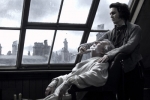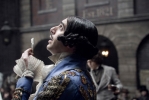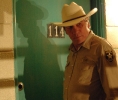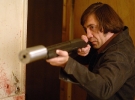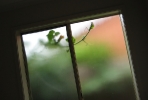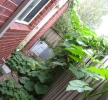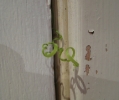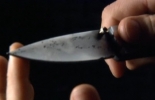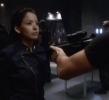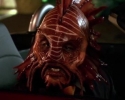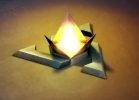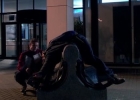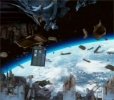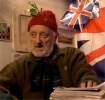Our hotel was just off Djeema el Fna, the central square in Marrakech’s
medina (old town) and its heart. To the north of it are the souqs — an
unbelievable rabbit warren of market stalls selling all kinds of
merchandise. The buzz of the crowds weaving in and out of each other is
enlivened all the more so by the moped riders intent on tearing their way
through its narrow pathways.
But as crazy as the souqs are by day, it was after dark that the square
itself came to life in one of the most amazing spectacles I have
witnessed. We emerge from our hotel to be met by a throng of people out
for a Friday night (although later nights show that the crowd is almost as
large regardless of the day of the week). From towardes the square we can
here the voices of many more and the smoke and lights of their activities.
In the square which earlier contained only a few juice stands, snake
charmers and monkey owners trying to extract money from largely
disinterested tourists, a whole small town has appeared. In the centre
there are now about 30 restaurants each serving the staples of Morrocan
cuisine such as cous cous and tajines, with many sheeps’ heads proudly on
display. As we wandereed through there would be furious attempts to tempt
us in to each restaurant. At the start of each aisle we would be asked
our nationality or they would take a lucky guess that we were ‘espanol’
(apparently Rachelle and I look Spanish to the average Moroccan) but by
the end of the aisle, via some magical game of Chinese whispers, it would
already be known that we were Australian and we would be greeted by calls
of ‘Skippy!’, ‘Crikey!’ or most memorably on one occassion by ‘ Kimmie,
Kimmie, look at moi!’. To one side of the restaurants the juice stands of
earlier have been joined by dozens more selling dried fruit and nuts,
perfumes, spices and any ingredient you might need for your traditional
medicine. On the other are scores of performers — acrobats, traditional
musicians, slapstick comedians, story tellers, fortune telles and at least
one or two whose act I couldn’t work out — each surrounded by a small
circle of people enjoying their evening’s entertainment. Apparently this
sight was once common across Morocco but the advent of modern life and TV
has led to its slow disappearance. There were even plans to replace the
Djeema el Fna with a car park but thankfully wiser heads prevailed.
Having explored we went for dinner at one of the many restaurants with
roof top terraces around the square. Looking down at the chaos below was
an unbelievable sight. The effect was only heightened when the call to
evening prayer rang out from the half dozen minarets around and nearby the
square. As became our habit, after dinner we headed back into the melting
pot of sights sounds and smells and had a mint tea with the customary
Moroccan seven teaspoons of sugar (by the third night and serious
negotiations we were good enough friends with our waiter to get our hands
on some with a mere three, albeit on the proviso that we tried a Moroccan
dessert no doubt containing an additional 13).
Our first two full days in Marrakech were spent exploring its sights.
Highlights included a medersa (Islamic school) set in a beautiful
building. As in any Islamic religious building there are no paintings or
drawings. The decoration in the central courtyard is therefore zellij —
the patterned mosaics made with small colourful tiles that are seen
everywhere in Morocco — and stone and wood exquisitely carved with Arabic
and abstract symmetric patterns. Around this courtyard over two levels
are the rooms where the students studying here would have lived. Some of
the rooms have windows opening on to the courtyard below and were perhaps
the size of a small study while others were windowless and barely had room
for a mattress. Apparently the allocation was based on the quality of
students’ work providing added incentive to work hard if Allah’s
omniscience wasn’t enought.
We also visited the Palais el-Badi — an impressive palace built in the
16th century. Much of its more stunning features were plundered by later
generations but the scale of its 100m+ long central court with pools of
water and groves of oranges is still impressive. The palace is also home
to one of the most beautifully designed Islamic minbars (a pulpit — and
not a minibar as I initially read, a concept which seemed somewhat at odds
with the forbidden status of alcohol in the religion).
From here we head to the Saadian Tombs, our arrival delayed somewhat by an
enterprising storekeeper who had painted in the alleyway outside his shop
“Les tombeaux Saadiennes <=”. Needless to say, les tombeaux Saadiennes
were nowhere to be found within his shop, although much reasonably priced
arts and crafts could be. When we finally made it, the tombs were well
worth the detour, as they were decorated with the most beautiful and
detailed examples of zellij and carving we had yet seen.
Even when not being led astray by devious shop owners, walking between the
sights was as much an experience as the destinations themselves.
Everywhere the smells were overpowering, be they pleasant or (more often)
not. The pedestrianised streets were that in name only with bikes,
mopeds, carts and donkeys weaving in and out of the crowds. Crossing the
road was a game of Russian roulette without the luxury of knowing when
exactly the trigger would be pulled. The technique was not dissimilar to
any early computer game where a river must be crossed by jumping on
successive logs before they fall over a water fall. Whether a log (gap)
further across appears before the current one reaches the waterfall (gets
filled by a rapidly moving bus) depends only on the random number
generator inside the computer (vagaries of Marrakechian traffic).
Initially we were rather hesitant to play the game but after a few days
were playing it as brazenly as any local.
On our final day in Marrakech we decide to take a trip to Cascade d’Ouzoud, about 150km from the city. The drive was an experience in itself. Being in the car was a nerve racking experience — be it overtaking with rapidly oncoming traffic careening towards us, virtually forcing cyclists into roadside ditches or heading round mountain bends with only minimal use of the brakes. When I was able to remove my hands from in front of my eyes however, I got to see the barren country surrounding the city. While there were some areas of irrigated crops or olive trees, for the most part the rocky, hilly red earth is covered only with sparse shrubs.
Arriving in Ouzoud we (Rachelle, I and the two French in the car with us) are led down to the top of the waterfalls that are the reason for our visit by the first of our many prospective guides. As he shows us to the edge (no barrier of course), the 110m drop to the bottom is enough to make me take a step back. After leading us this far we tell our guide that his services are not required to take us down the gorge to the base of the falls, having been informed by the Lonely Planet that any simpleton can find their way down. Emboldened, we intrepidly set off but every route that we take down, while taking us a little further than the last, ends up at a point we cannot pass. The subsequent re-assent invariably leads to another potential guide appearing from the bushes offering to show us the way down but, encourged by the Lonely Planet’s words (and determined to show ourselves not sub-simpleton) we wave him away. After a while a couple of Aussies come along so we tack along with them. Again we make it further down than previously but are stuck when we hear someone calling to us that there is no way down the way we are headed and to follow him. His long goatee and scarf over hsi head mean he doesn’t look typically Moroccan and we are unsure whether he is a helpful fellow tourist or a guide after money but tentatively we follow him down. It turns out he — Sayeed — is neither but rather a Moroccan who lives in the valley and is happy to show us some of his favourite spots for free.
He is a quietly spoken man of about 30 and speaks well in English, French and German. He is clearly deeply in love with his surroundings and indeed shows us to some spectacular spots. The scenery is amazing — the walls of the gorge rising up to either side and the river flowing down the middle occasionally going over a small waterfall which below make perfect pools for a swim (although we elect not to). Battliong our way through reeds and clambering over rocks, we eventually reach a point where this river joins another. THere we find some caves which we explore. Standing outside them and looking down the gorge with its steeply rising walls of red rock, spars vegetation and families of goats precariously trying to find their way down is a stunning sight that prompts Rachelle to exclaim “This is crazy”, to which Sayeed calmly replies “No, this is reality”.
We head back stopping for lunch and a mint tea at a ‘cafe’ which is really just a couple of tables sitting outside the house of some of Sayeed’s friends, after which we rush back to ensure we don’t miss our lift back to the city, pausing only briefly to see the waterfalls which had been the reason for our trip but now seem somewhat less important after the other more hidden sights we have seen.
That evening we head out one last time to witness the sensory overload that is the Djeema el Fna. The following morning it is time to move on and I am very sad to be leaving.




